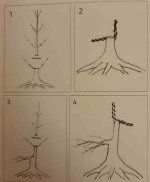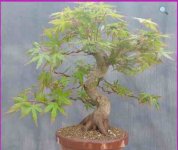Hi Bonsainuts
When I first started about a year ago, I assumed, like most beginners probably do, that if I got my hands on an acer or oak, or any kind of sapling, that if it was 2ft tall and I wanted a 2ft tall trunk, that it was a case of waiting for it to thicken.
As I've studied more I have come to learn that taper is built through successive chop trunks, rewiring of new shoots to create each new trunk segment, as shown in Meriggioli's fantastic book below:

I feel like I can begin to see in my own trees (practically saplings), the places where I want to chop and begin building the next part of the trunk.
My question and problem understanding, is how to begin to tell where to make these chops on more developed material (pics below)
Does this come with time, experience and patience ? (My guess is yes).
For example, I'm considering purchasing something like this, to have something a little further in development to improve my skills:

Or this:

To my inexperienced eye, the first tree has some good movement, some taper, perhaps a little inverse taper half way up the trunk, but there are several branches in the apex that could be the next leader.
The second piece of nursery stock has great movement (to me) and I feel like both trees could be worked as they are, into lovely trees - but I'm having trouble seeing where or how cuts would be made to take these two examples of nursery stock, towards something like this (below), where there is obvious taper and building of each trunk section.

(Another amazing tree in the Meriggioli book)
I hope what I am asking makes sense. It would be easier to explain what I mean verbally but Unfortunately I can only make it to my local club a handful of times per year and am reliant on books, this site, YT.
Thanks !
When I first started about a year ago, I assumed, like most beginners probably do, that if I got my hands on an acer or oak, or any kind of sapling, that if it was 2ft tall and I wanted a 2ft tall trunk, that it was a case of waiting for it to thicken.
As I've studied more I have come to learn that taper is built through successive chop trunks, rewiring of new shoots to create each new trunk segment, as shown in Meriggioli's fantastic book below:

I feel like I can begin to see in my own trees (practically saplings), the places where I want to chop and begin building the next part of the trunk.
My question and problem understanding, is how to begin to tell where to make these chops on more developed material (pics below)
Does this come with time, experience and patience ? (My guess is yes).
For example, I'm considering purchasing something like this, to have something a little further in development to improve my skills:

Or this:

To my inexperienced eye, the first tree has some good movement, some taper, perhaps a little inverse taper half way up the trunk, but there are several branches in the apex that could be the next leader.
The second piece of nursery stock has great movement (to me) and I feel like both trees could be worked as they are, into lovely trees - but I'm having trouble seeing where or how cuts would be made to take these two examples of nursery stock, towards something like this (below), where there is obvious taper and building of each trunk section.

(Another amazing tree in the Meriggioli book)
I hope what I am asking makes sense. It would be easier to explain what I mean verbally but Unfortunately I can only make it to my local club a handful of times per year and am reliant on books, this site, YT.
Thanks !
Attachments
-
 20250426_212749.jpg78.6 KB · Views: 43
20250426_212749.jpg78.6 KB · Views: 43 -
 Screenshot_20250427_095535_Brave.jpg140.6 KB · Views: 35
Screenshot_20250427_095535_Brave.jpg140.6 KB · Views: 35 -
 Screenshot_20250427_095756_Brave.jpg13.7 KB · Views: 8
Screenshot_20250427_095756_Brave.jpg13.7 KB · Views: 8 -
 20250427_102459.jpg37.7 KB · Views: 8
20250427_102459.jpg37.7 KB · Views: 8 -
 Screenshot_20250427_095756_Brave.jpg13.7 KB · Views: 10
Screenshot_20250427_095756_Brave.jpg13.7 KB · Views: 10 -
 Screenshot_20250427_095756_Brave.jpg13.7 KB · Views: 38
Screenshot_20250427_095756_Brave.jpg13.7 KB · Views: 38





